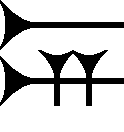Ni (cuneiform) on:
[Wikipedia]
[Google]
[Amazon]
 The
The
 The
The cuneiform
Cuneiform is a logo-syllabic script that was used to write several languages of the Ancient Middle East. The script was in active use from the early Bronze Age until the beginning of the Common Era. It is named for the characteristic wedge-sh ...
sign ni is a common-use sign of the Amarna letters, the ''Epic of Gilgamesh
The ''Epic of Gilgamesh'' () is an epic poem from ancient Mesopotamia, and is regarded as the earliest surviving notable literature and the second oldest religious text, after the Pyramid Texts. The literary history of Gilgamesh begins with ...
,'' and other cuneiform texts. It has a secondary sub-use in the Amarna letters for addressing the Pharaoh, from the vassal states of Canaan
Canaan (; Phoenician: 𐤊𐤍𐤏𐤍 – ; he, כְּנַעַן – , in pausa – ; grc-bib, Χανααν – ;The current scholarly edition of the Greek Old Testament spells the word without any accents, cf. Septuaginta : id est Vetus T ...
. The address to the Pharaoh is often 'King-Lord-Mine': ''LUGAL, EN-ia'' which has many varieties of expression. "LUGAL" is Akkadian language
Akkadian (, Akkadian: )John Huehnergard & Christopher Woods, "Akkadian and Eblaite", ''The Cambridge Encyclopedia of the World's Ancient Languages''. Ed. Roger D. Woodard (2004, Cambridge) Pages 218-280 is an extinct East Semitic language th ...
for "Šarru", English "king", and ''EN'' in Akkadian is ''bēlu'', for "Lord", (thus "King, Lord-Mine"). In some Amarna letters the sub-use of ''ni'' is ''lí'', for spelling "bēlu", '' be-lí'' often .
There are other sub-uses of ''ni'' (see ''Epic of Gilgamesh'' usage below). It is also found in some Amarna letters, EA 9, and EA 252, for example where ''ni'' or ''lí'' is scribed in a "flourish" format (an over-lengthened version of the two-horizontals that construct the sign), similar to '' tab'', . In EA 9 especially, there is a ' scribe margin line', both left and right on the clay tablet
In the Ancient Near East, clay tablets ( Akkadian ) were used as a writing medium, especially for writing in cuneiform, throughout the Bronze Age and well into the Iron Age.
Cuneiform characters were imprinted on a wet clay tablet with a sty ...
obverse. For the right margin, some words in the lower paragraphs of the obverse (Para 4–7), some words ending with ''ni''/''lí'', have the sign lengthened, and sitting upon the right margin line-(the cuneiform text, in EA 9, reads: left-to-right).
''Epic of Gilgamesh'' usage
The ''ni'' sign usage in the ''Epic of Gilgamesh'' is as follows: ''lí''-(5) times, ''né''-(42), ''ni''-(326), ''ṣal''-(8), ''zal''-(1), ''Ì''-(9) times. Ì, theSumerogram
A Sumerogram is the use of a Sumerian cuneiform character or group of characters as an ideogram or logogram rather than a syllabogram in the graphic representation of a language other than Sumerian, such as Akkadian or Hittite.
Sumerograms are n ...
is Akkadian language "šamnu", for English "oil".
Because of its multiple usages in the Epic, ''ni'', or ''lí'', can be used as a syllabic for "
"ne", "ni", or "li"/"lí", etc. It also can be used as a syllabic for combinations related to: "sal", "ṣal", or "zal"; (in Akkadian many consonants, or the 4-vowels, ''a, e, i, u'' can be interchanged, for performing the final Akkadian language
Akkadian (, Akkadian: )John Huehnergard & Christopher Woods, "Akkadian and Eblaite", ''The Cambridge Encyclopedia of the World's Ancient Languages''. Ed. Roger D. Woodard (2004, Cambridge) Pages 218-280 is an extinct East Semitic language th ...
'dictionary word').
References
* Moran, William L. 1987, 1992. ''The Amarna Letters.'' Johns Hopkins University Press, 1987, 1992. 393 pages.(softcover, ) * Parpola, 1971. ''The Standard BabylonianEpic of Gilgamesh
The ''Epic of Gilgamesh'' () is an epic poem from ancient Mesopotamia, and is regarded as the earliest surviving notable literature and the second oldest religious text, after the Pyramid Texts. The literary history of Gilgamesh begins with ...
'', Parpola, Simo, Neo-Assyrian Text Corpus Project, c 1997, Tablet I thru Tablet XII, Index of Names, Sign List, and Glossary-(pp. 119–145), 165 pages.
Cuneiform signs